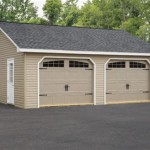How to Seal a Garage Door with Uneven Floor Joists
A garage door is a significant entry point into your home, and it plays a crucial role in protecting your belongings and maintaining a comfortable temperature inside. However, uneven floor joists can create gaps between the bottom of the door and the floor, allowing cold air, moisture, and even pests to enter. This can lead to increased energy bills, uncomfortable temperatures, and potential damage to your belongings.
Fortunately, sealing a garage door with uneven floor joists is a manageable project that can significantly improve the efficiency and security of your garage. This article provides a comprehensive guide to help you effectively seal your garage door and address the challenges posed by uneven floor joists.
Assess the Severity of the Uneven Joists
The first step is to determine the severity of the unevenness in your floor joists. This will guide your approach to sealing the gap between your garage door and the floor.
To accurately assess the unevenness, use a level and measure the difference in height across the floor joists. If the variation in height across the joists is minimal, you might be able to use weatherstripping as a simple solution. However, if the difference is significant, you might need to consider a more robust solution like door threshold adjustments or shims.
Choose the Right Sealing Method
Once you have assessed the severity of the uneven floor joists, you can select the most suitable sealing method. Here are some common techniques used for sealing garage doors with uneven floors:
1. Weatherstripping
Weatherstripping is a simple and effective solution for smaller gaps caused by minor unevenness in the floor joists. It is available in various materials, including rubber, vinyl, and foam, and can be easily attached to the bottom of your garage door. Choose a weatherstripping material that is compatible with your garage door material and the climate in your area.
2. Door Threshold Adjustments
If the unevenness in your floor joists is more pronounced, you might need to consider adjusting the door threshold. This involves raising the threshold to create a more even surface for the garage door. There are various techniques for adjusting the threshold, including using shims, adding a new threshold, or using adjustable threshold systems.
3. Door-Bottom Seal Kits
Door-bottom seal kits provide a comprehensive solution for sealing gaps between the bottom of the garage door and the floor. These kits typically include a flexible seal that forms a tight barrier against the floor, often combined with a door-bottom sweep for added protection against drafts and pests.
Implementing the Sealing Solution
Once you have chosen your preferred sealing method, it's time to implement the solution. Here are some general steps to follow:
1. Prepare the Garage Door
Start by cleaning the bottom of the garage door and the existing seal, if any. This ensures a clean surface for the new seal to adhere to. Remove any existing weatherstripping or seals that might be interfering with the new installation.
2. Install the New Seal
Follow the manufacturer's instructions for installing your chosen seal. This might involve attaching it to the bottom of the door, placing it on the floor, or using specific clips or screws. Ensure the seal is securely attached and forms a tight seal against the floor.
3. Test the Seal
Once the seal is installed, test it by opening and closing the garage door several times. Observe the seal's performance and check for any gaps or leaks. If necessary, adjust the installation to ensure a tight seal.
Maintenance and Inspection
Maintaining your garage door seal is crucial to ensure its effectiveness over time. Regularly check the seal for any wear and tear, damage, or gaps. Replace or repair any damaged sections promptly to prevent further issues.
By following these steps, you can effectively seal your garage door, even if you have uneven floor joists. This will help you improve the efficiency and safety of your garage, keeping it comfortable and protected.

Level An Uneven Crowning Subfloor By Planing Sanding Joists

Level An Uneven Crowning Subfloor By Planing Sanding Joists

Floor Levelling Explained An Expert Guide Craftedforlife

5 Reasons Your Floor Joists May Cause Uneven Flooring Doityourself Com

Floor Levelling Explained An Expert Guide Craftedforlife

Fix Replace Damaged Floor Joists How To Sister A Joist

Teckentrup Door Solutions

The Dangers Of Sagging Floor Joists How To Get Them Fixed

Floor Levelling Explained An Expert Guide Craftedforlife

Diy How To Level A Uneven Wavy Or Sloping Wood Floor
Related Posts








